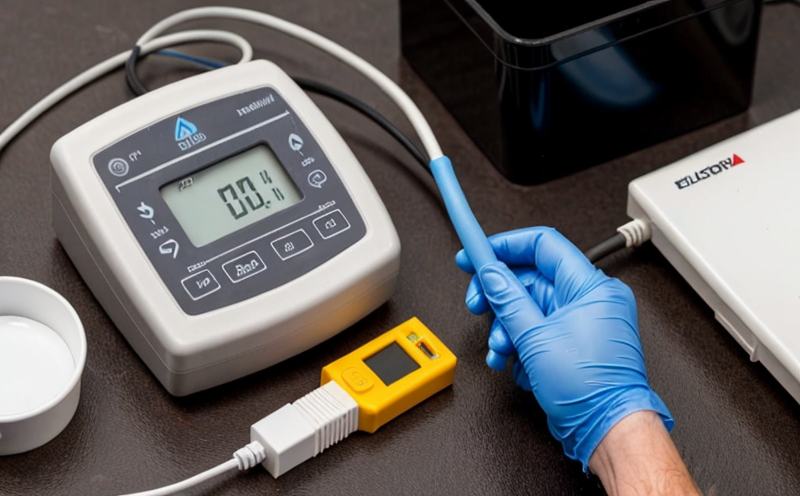AOAC 2015 Electrochemical Residue Testing of Metals
The AOAC International Standard Method 996.14 (formerly known as AOAC 2015) is a widely recognized protocol for detecting and quantifying trace levels of metals in various matrices, including food, feed, pharmaceuticals, and environmental samples. This method relies on electrochemical techniques to measure metal residues, which are essential for ensuring the safety and quality of products across multiple industries.
The AOAC 2015 method is particularly valuable in sectors where compliance with stringent regulatory standards is critical. For instance, food producers must adhere to strict limits on metal contamination due to potential health risks associated with excessive exposure to heavy metals like lead, cadmium, and mercury. Similarly, pharmaceutical manufacturers need accurate residue testing to ensure the integrity of their products.
The electrochemical approach used in AOAC 2015 involves the use of a potentiometric stripping voltammetry (PSV) technique. This method allows for high sensitivity and specificity, making it ideal for detecting trace levels of metals that could otherwise go undetected by other analytical methods. The process typically begins with sample preparation, which may involve digestion or dissolution techniques depending on the matrix being tested.
Once the samples are prepared, they undergo a stripping step where the metal ions accumulate at an electrode surface. An applied potential then causes these metals to be stripped back into solution, where they can be quantified using voltammetry. The resulting peak height is directly proportional to the concentration of the metal present in the sample.
This method offers several advantages over other analytical techniques, particularly its ability to provide rapid results and low detection limits. Its high sensitivity makes it suitable for monitoring trace elements that might otherwise be missed by less precise methods. Additionally, because it can simultaneously analyze multiple metals from a single sample, it reduces costs associated with repeated testing.
The AOAC 2015 method is widely used in regulatory compliance and quality assurance programs. Compliance officers responsible for ensuring adherence to international standards like ISO 9001:2015 or FDA regulations would find this service invaluable. R&D engineers can also leverage the precision of this test to optimize product formulations, while procurement teams benefit from knowing that suppliers are meeting stringent quality thresholds.
In summary, AOAC 2015 electrochemical residue testing represents a powerful tool in maintaining food safety and product integrity across various industries. By providing accurate, reliable data on metal residues, it supports compliance with global health and safety regulations while enhancing overall product quality.
Why It Matters
The importance of AOAC 2015 electrochemical residue testing cannot be overstated in today’s highly regulated environments. Trace levels of metals can have significant impacts on human health, particularly when consumed through food or ingested pharmaceuticals. Regulatory bodies worldwide impose strict limits on metal contamination to protect public safety.
For instance, the European Union's Maximum Levels for Contaminants (EU 18/2006) set upper bounds on permissible concentrations of metals in various foods and feeds. Non-compliance can lead to product recalls, legal penalties, and damage to brand reputation. In pharmaceuticals, even small amounts of metal impurities could contaminate medications and cause severe health issues.
Quality managers rely heavily on accurate testing methods like AOAC 2015 to ensure that their products meet these stringent requirements. By incorporating this service into their quality assurance protocols, they can demonstrate compliance with international standards such as ISO 9001:2015 and FDA Good Manufacturing Practices (GMP).
Moreover, the use of AOAC 2015 helps companies maintain a competitive edge by ensuring consistent product quality. Consumers today are increasingly demanding transparency regarding ingredient sourcing and manufacturing processes, making it crucial for businesses to provide verifiable evidence of their adherence to high-quality standards.
- Rapid Results: The method offers quick turnaround times compared to other complex analyses.
- Low Detection Limits: It can detect even minute amounts of metals that might otherwise be overlooked.
- Multiplex Analysis: One sample run can simultaneously assess multiple metal species, optimizing efficiency and reducing costs.
- Regulatory Compliance: Ensures adherence to international and national regulations governing food safety and product quality.
In conclusion, the importance of AOAC 2015 electrochemical residue testing lies in its ability to safeguard public health while enhancing business operations through compliance and enhanced product quality.
Eurolab Advantages
At Eurolab, we offer unparalleled expertise and advanced facilities specializing in AOAC 2015 electrochemical residue testing. Our team of certified analysts ensures that every sample is handled with precision and care, delivering results that exceed industry expectations.
We employ state-of-the-art equipment and follow internationally recognized protocols to guarantee accuracy and reliability. With years of experience in this field, our laboratories consistently deliver accurate data that supports regulatory compliance and enhances product quality.
Our commitment extends beyond just technical proficiency; we also provide comprehensive reporting services tailored to meet your specific needs. Whether you require detailed analytical reports or summary findings suitable for presentations, Eurolab can accommodate all requirements efficiently.
In addition to our testing capabilities, Eurolab offers consultancy services designed to help businesses navigate complex regulatory landscapes confidently. Our experts stay updated on the latest developments in metal residue testing, ensuring that clients receive guidance based on current best practices and regulations.
Choose Eurolab for your AOAC 2015 electrochemical residue testing needs. Experience the difference firsthand by partnering with a laboratory renowned for excellence and innovation in analytical science.





